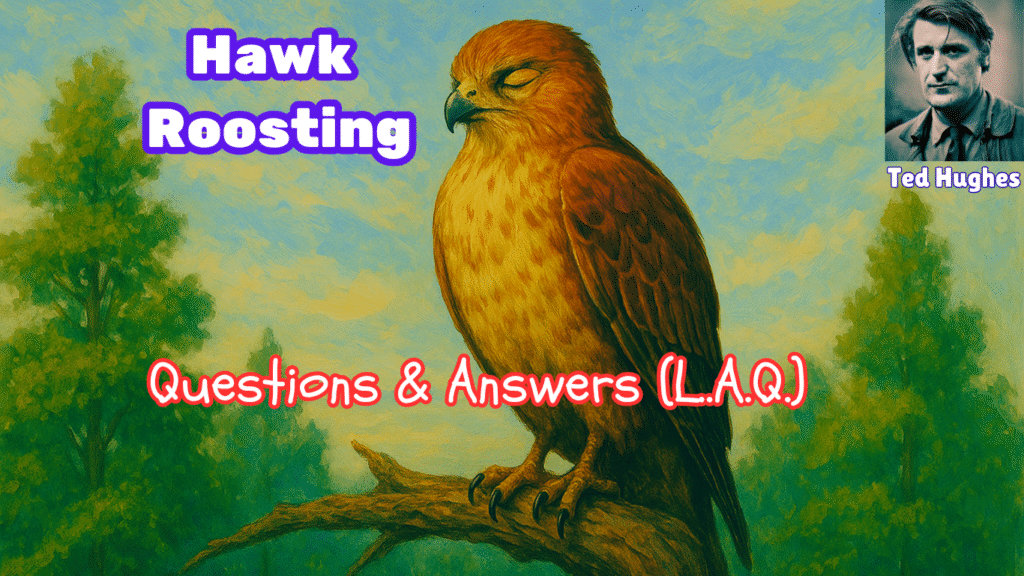
1) Comment on the physical features and powers of the hawk. Discuss their significance. (WBCHSE Model Question)
Ans. The hawk possesses physical features like a hooked beak, sharp claws and strong wings. These powerful tools make him an efficient hunter. His hooked feet give him a strong grip upon the rough bark. No force can stir him against his will. His keen eyesight helps him detect any movement in the ground. His manner is brutal. He tears off its prey. Through these physical and mental traits, he dominates and controls the natural world.
2) “I took the whole creation
To produce my foot, my each feather:
Now I hold creation in my foot.”
What does the hawk mean by saying that the whole creation produced it? How does the statement reflect the hawk’s arrogance and sense of superiority? [3+3]
Ans. The hawk symbolises the fact that all natural forces have combined to make him so deadly and powerful. His hooked beak, sharp claws and strong feathers are made so accurately. He believes that all are created purposefully to make him a great predator.
The statement of the hawk strongly shows his arrogance, confidence and sense of superiority. Being a favoured creature of nature, he has the absolute power to dominate over everything on this earth. He thinks nature’s only purpose is to serve him and make him superior to all the creatures.
3) “No arguments assert my right: the sun is behind me”
How can this line be interpreted as a metaphor for dictatorship for absolute authority? [6]
Ans. This line can be interpreted as a metaphor for dictatorship because the hawk believes that his power and authority are beyond any question and are supported by the divine. A dictator does not need any consent to justify his actions. In the same way, the hawk can kill any creature whenever it wishes. No one can challenge its power and dictatorship.
‘The sun is behind me’ – this line signifies that his actions are backed by nature. So, this line is the perfect example of a metaphor, like a tyrant ruler.
4) Justify the title of the poem ‘Hawk Roosting’. [6]
Ans. The title of the poem ‘Hawk Roosting’ is very appropriate and symbolic. The hawk is the central figure of the poem, a bird of prey that symbolises pride, power and dominance. The word roosting means resting or relaxing, sitting at the top of the tree with eyes closed. But it is not that he was absorbed in false fantasies. He stays alert while he is relaxing. He has control over everything and detects every moment on the earth. He rehearses perfect killing and eating its prey.
So, the title ‘ Hawk Roosting’ reflects the physical image as well as the inner World of the hawk. Thus, the title is appropriate.
5) Analyse ‘Hawk Roosting’ as a dramatic monologue. [6]
Ans. Ted Hughes’ poem ‘Hawk Roosting’ is a fine example of a dramatic monologue. In a dramatic monologue, a single speaker expresses his thoughts and feelings to a silent listener. He also reveals his personality through his own words. In the poem, ‘Hawk Roosting’, the hawk itself is the speaker speaking in first person – “I sit in the top of the wood”, “I hold creation in my foot”, etc. We found no silent listener in the poem. But the audience is the silent listener here. Through his self-revelation like “rehears perfect kills and eat”, “I kill where I please”, “my manners are tearing off heads”, the hawk unfolds his inner voice of domination, arrogance, pride and power. Thus, the poem fulfils all the criteria as a perfect dramatic monologue.
6) What kind of imagery did Ted Hughes use in the poem ‘Hawk Roasting’?
Ans. In the Poem ‘Hawk Roosting’, Ted Hughes uses the vivid and powerful imagery to express the hawk’s sense of arrogance, power and authority. Visual Imagery like “I sit in the top of the wood”, “The sun is behind me” helps the reader to see the hawk’s commanding position. “The air’s buoyancy and the sun ray” is an example of Natural Imagery that suggests nature’s support to the hawk. “My manners are tearing off heads” and “I kill where I please” are the example of Physical or Violent Imagery. These images show the brutality of hawk.
You may also read:
Hawk Roosting – Questions and Answers (S.A.Q.)
Hawk Roosting – Summary with Bengali Meaning